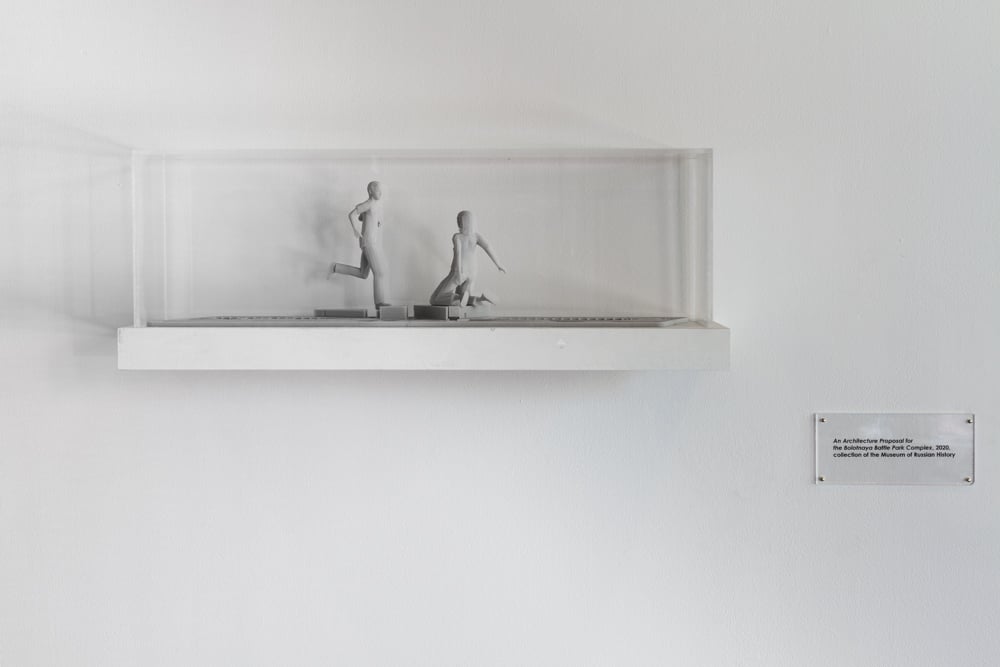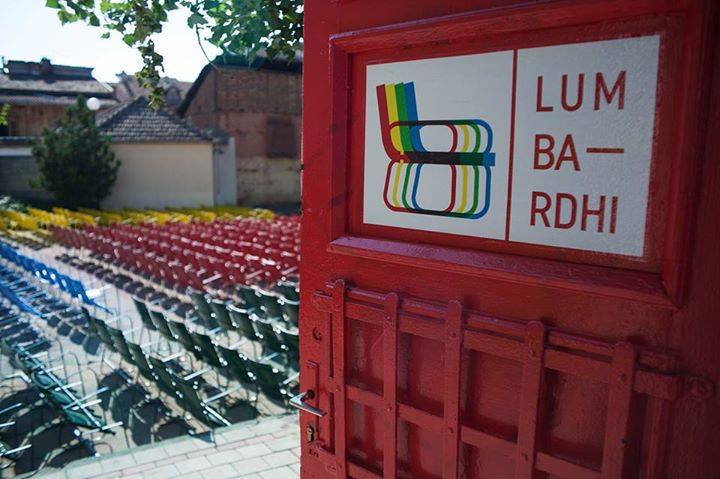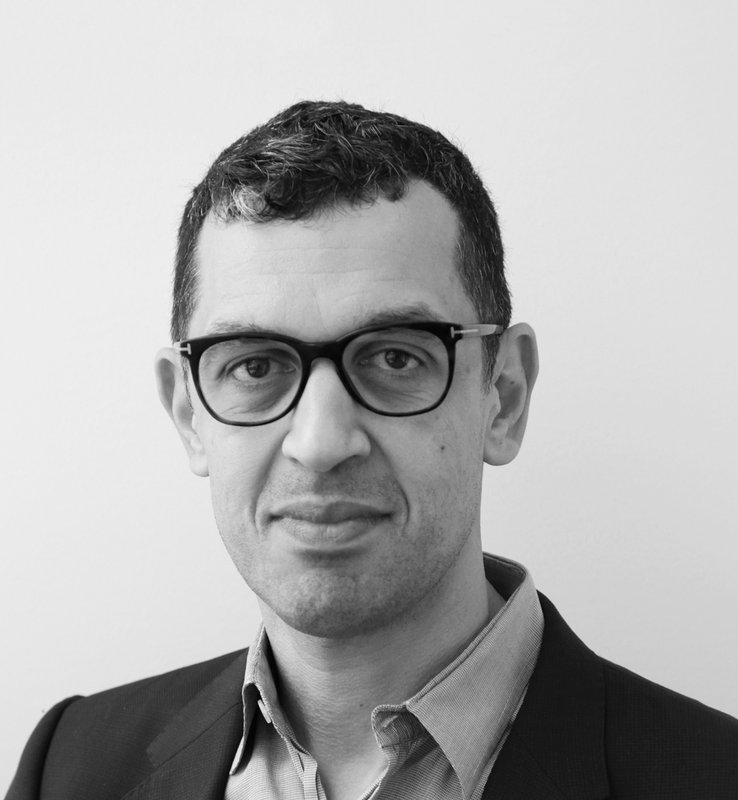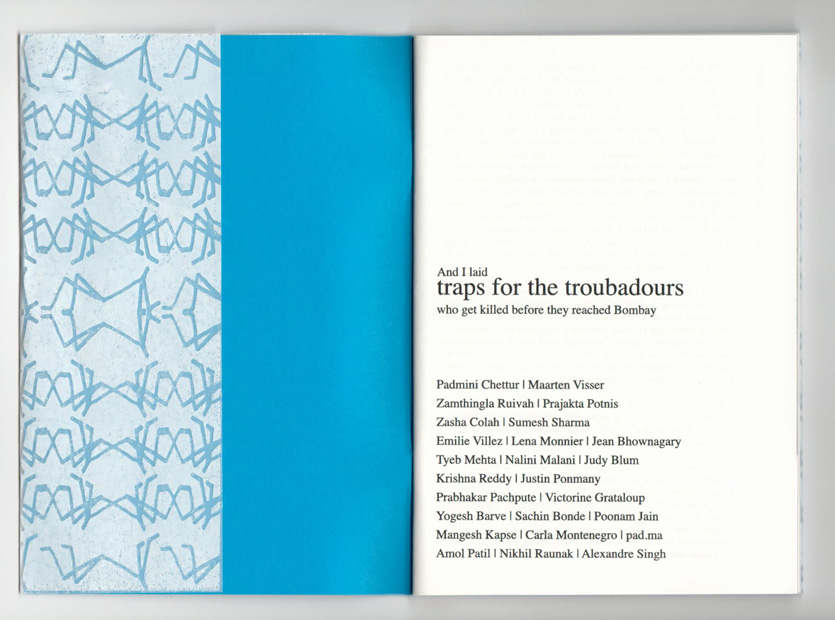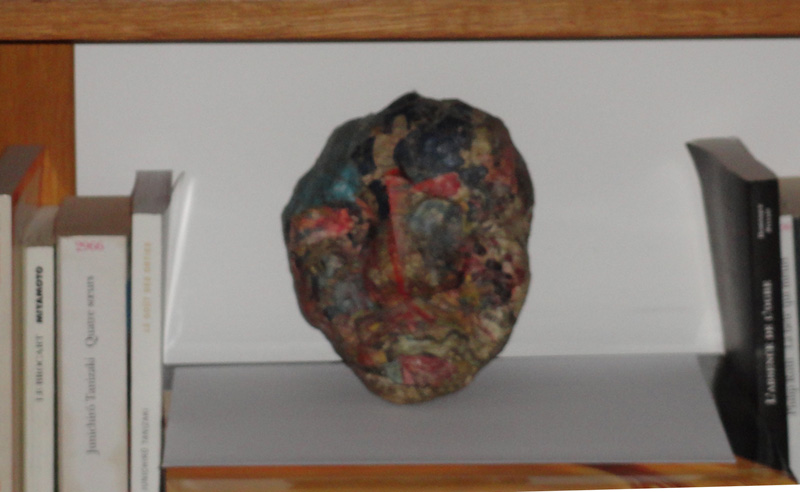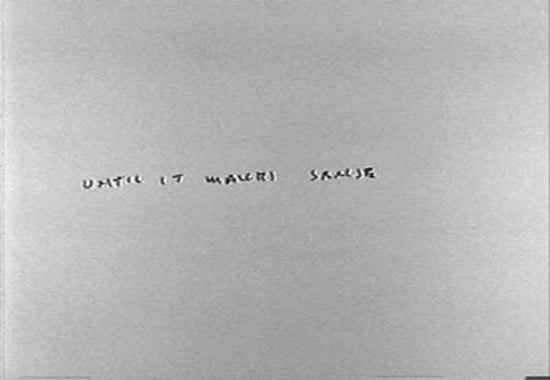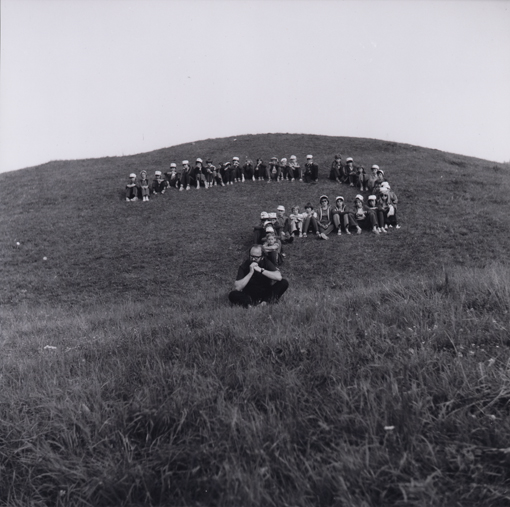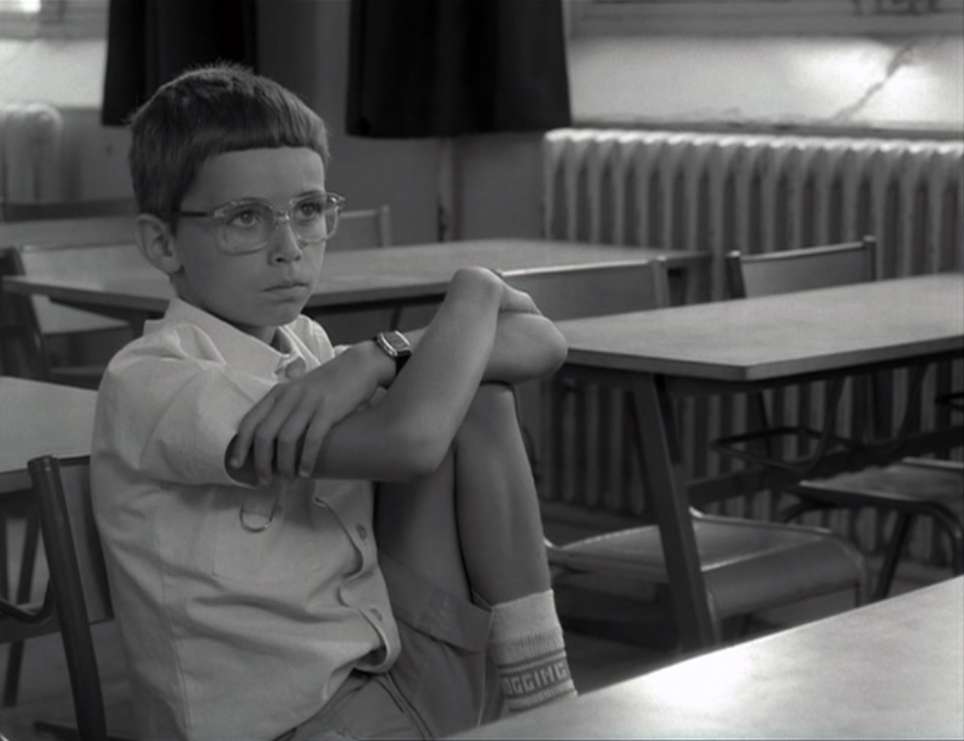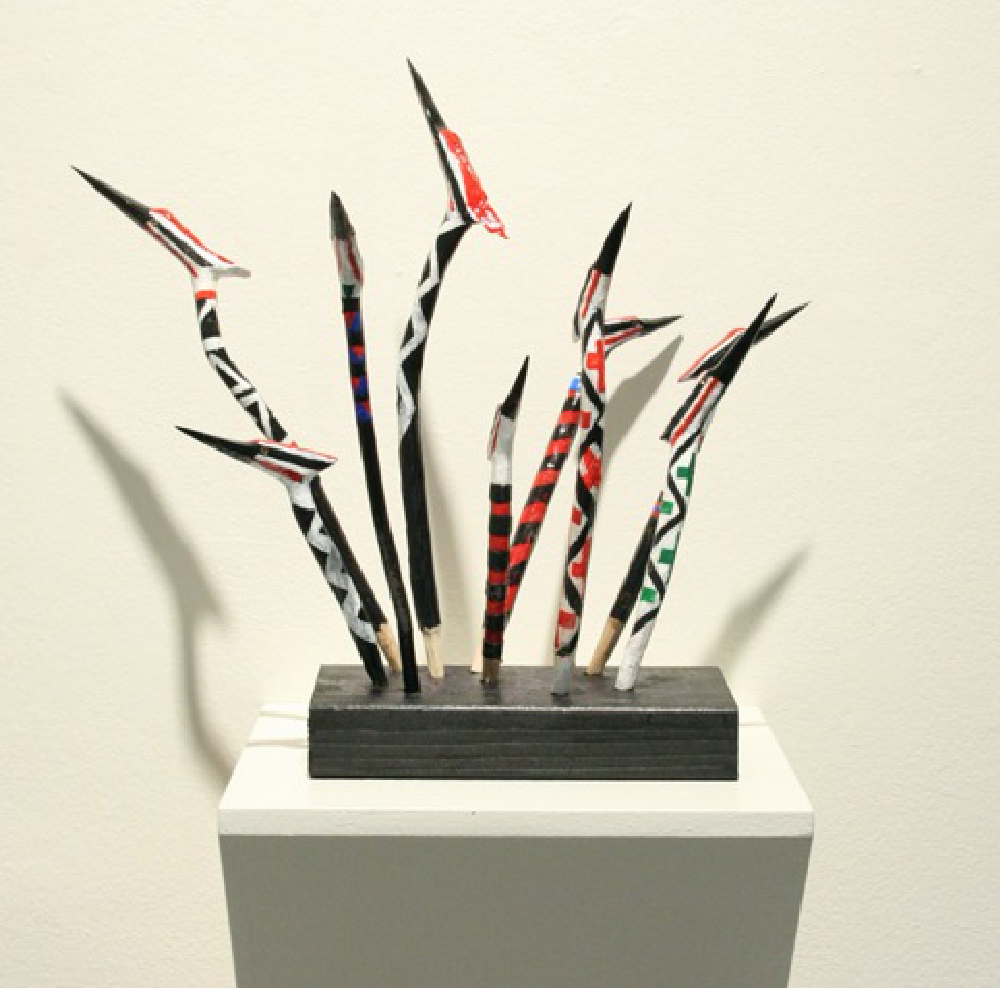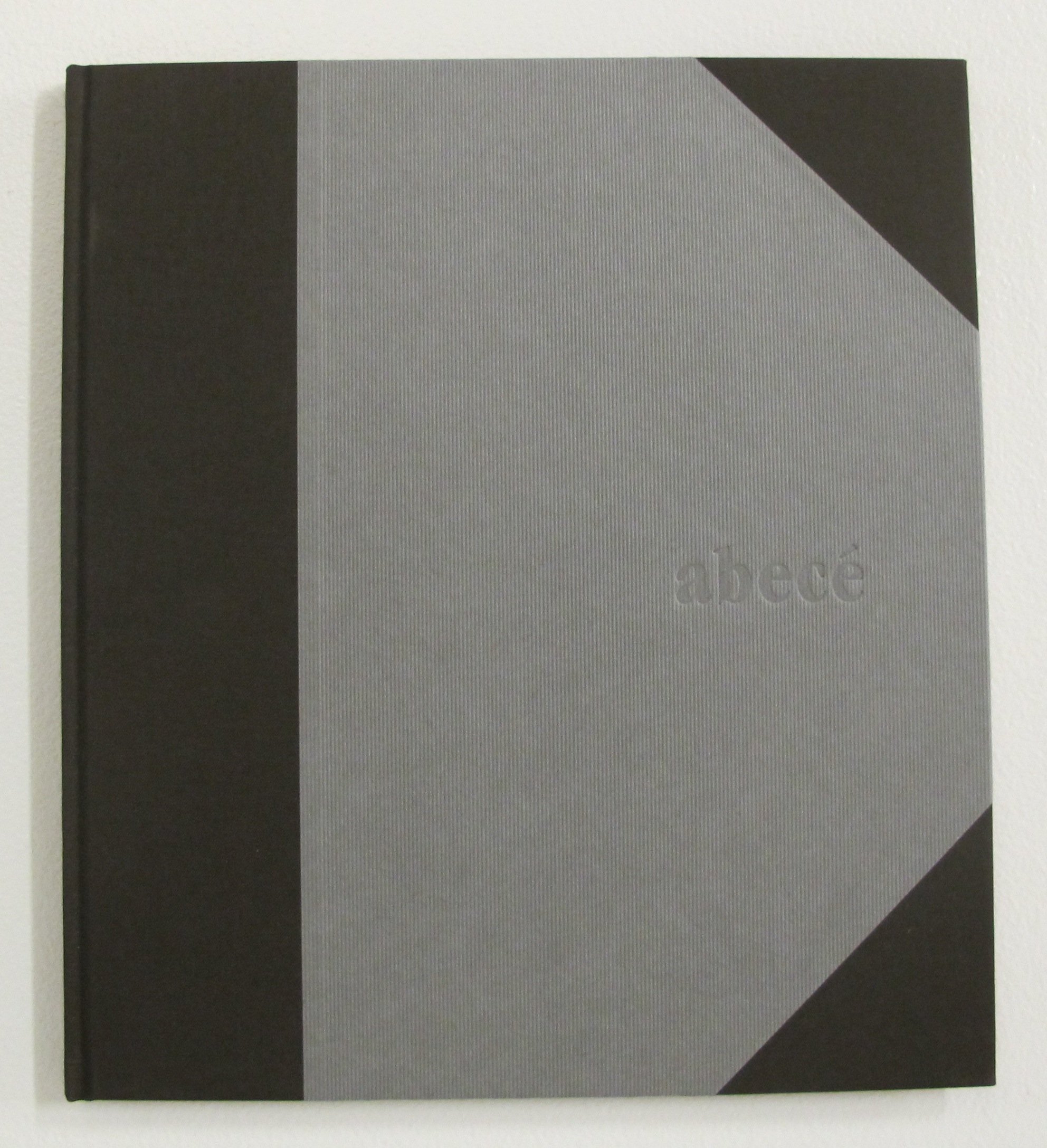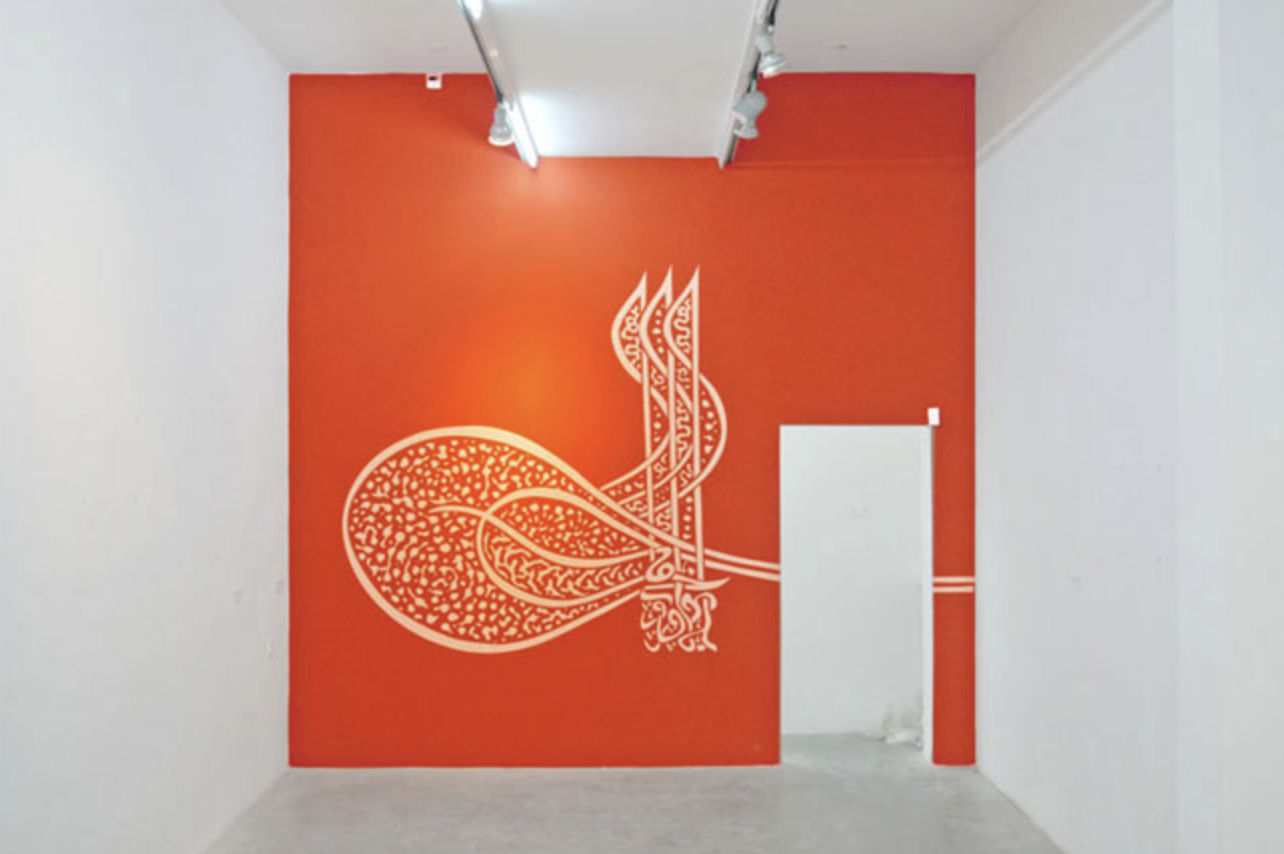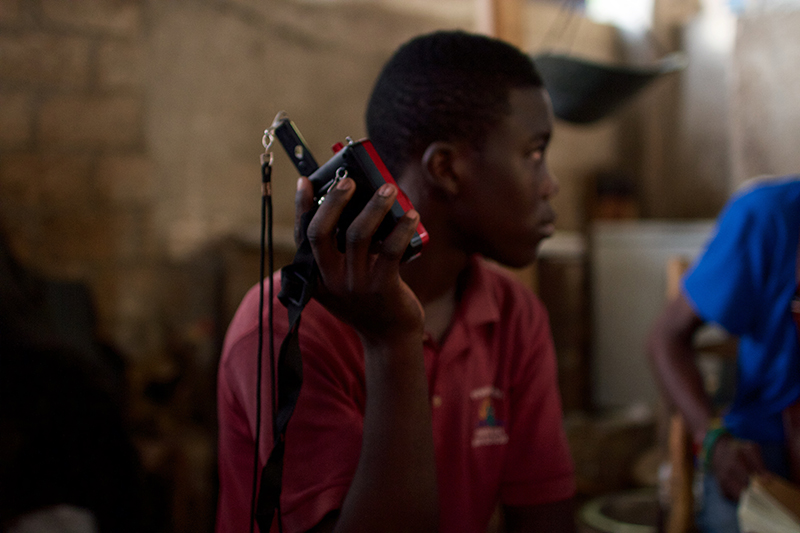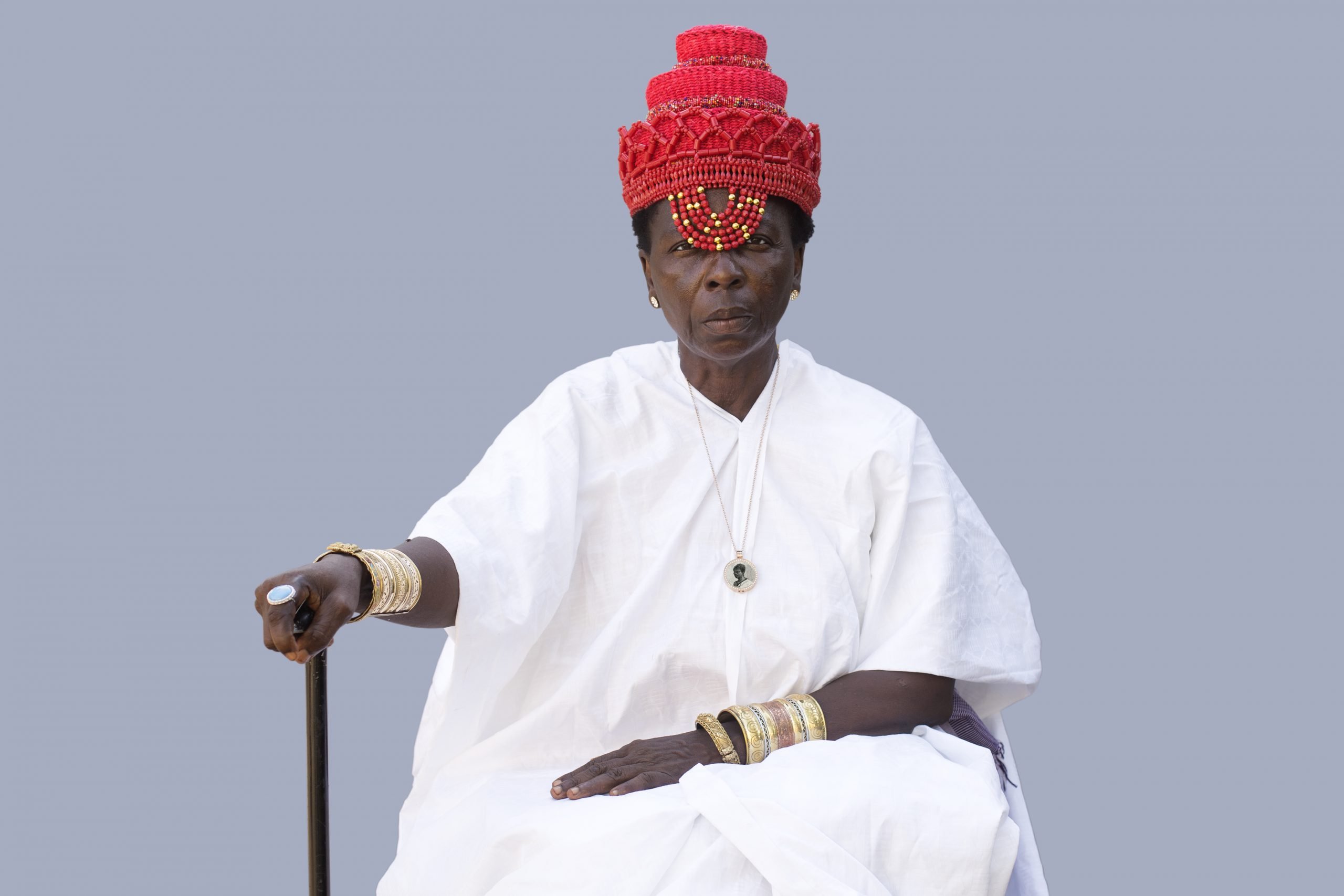
© » KADIST
Jorge González
Easy to fold and carry, Jorge González’s Banquetas Chéveres (Chéveres Stools) embody the nomadic and flexible nature of the Escuela de Oficios. González’s work employs a modernist language while paying homage to artisanal techniques specific to Puerto Rico and the Indigenous knowledge, people, and histories of the Carribean. Reinterpreting the furniture line ArKlu (1945-1948) conceived by the architects Stephen Arneson and Henry Klumb, the stools were conceived in collaboration with various artisans in Puerto Rico–Eustaquio Alers, a weaver from Aguadilla, Joe Hernández from Ciales, and MAOF from San Juan, a contemporary wood-salvaging collective, among others.

© » KADIST
Gregory Halpern
Gregory Halpern spent five years shooting ZZYZX , and another year editing the results, from an estimated thousand rolls of film, about half of which were shot in the final year after his Guggenheim Fellowship enabled him to live in California. According to Halpern, the series “is grounded in reality, but it occupies an in-between space, between documentary and a certain sense of mystery.” …“I see ZZYZX as part of a continuum but edging a little closer towards fiction.” The series title is borrowed from the village Zzyzx (pronounced zye-zix), formerly Soda Springs, but rechristened by the mineral water pioneer, Curtis Howe Springer, in 1944. The eccentric Springer named it after what he claimed to be the last word in the English language.

© » KADIST
Katia Kameli
Katia Kameli’s film The Storyteller explores the cultural role of deep-rooted artistic tradition in Morocco. Marrakech’s largest public square is well known for its al-halqa , a storyteller’s circle or circle of spectators. Abderrahim Al Azalia is a hlaïqya; it is his role to animate the al-halqa.

© » KADIST
Pierre Gonnord
Bimba y Delfin is part of a larger body of work by Pierre Gonnord focusing on the analysis and description of the lifestyles of urban youth in large Western cities. These images reflect on new canons of beauty, and the appearances and simulacra of fashion for a new generation. In particular, these works consider themes of androgyny, crossbreeding, and recycling.

© » KADIST
Angelica Mesiti
Angelica Mesiti’s piece, The Calling (2013-14) is a poignant exploration of ancient human traditions evolving and adapting to the modern world. The three-channel work focuses on traditional whistling languages and shows the communities of the village of Kuskoy in Northern Turkey, the island of La Gomera in the Canary Islands, and the island of Evia, Greece, where such languages are all still in use. For these communities, whistling languages are in a process of transformation from their traditional use as tools for communication across vast lands into tourist attractions and cultural artifacts and are being taught to local school children.

© » KADIST
Matthew Angelo Harrison
In Bodily Study of Unthinking Groups, Harrison combines two disparate materials into one stratified stack: automotive clay (used in detailing cars) forms the earthy base, while fragments of zebra skull become imbedded in this falsified soil. Harrison’s forged archeological artifact compresses two cultural contexts together: that of Africa, represented by the bleached zebra skull; and that of Detroit, the birthplace of the American car. Detroit’s Matthew Angelo Harrison works at the intersection of sculpture and technology, building his own 3D printers (which rise to the status of sculpture), and using these creations to formulate others.

© » KADIST
Gregory Halpern
Gregory Halpern spent five years shooting ZZYZX , and another year editing the results, from an estimated thousand rolls of film, about half of which were shot in the final year after his Guggenheim Fellowship enabled him to live in California. According to Halpern, the series “is grounded in reality, but it occupies an in-between space, between documentary and a certain sense of mystery.” …“I see ZZYZX as part of a continuum but edging a little closer towards fiction.” The series title is borrowed from the village Zzyzx (pronounced zye-zix), formerly Soda Springs, but rechristened by the mineral water pioneer, Curtis Howe Springer, in 1944. The eccentric Springer named it after what he claimed to be the last word in the English language.
![Elevación [Elevation]](https://kadist.org/wp-content/uploads/2022/09/IMG_escena001_3513-scaled.jpg)
© » KADIST
Ana María Millán
Interested in role-play and videogames, Ana María Millán developed workshops with different communities in order to create characters and scenarios for her animations, often in collaboration with a choreographer. Elevación evokes various narratives inspired by the comicstrip Marquetalia, Raíces de la Resistencia (Marquetalia, Roots of the Resistance) (2011). This comic strip is a memoir of the FARC (Revolutionary Armed Forces of Colombia) guerillas written by Jesús Santrich, one of its leaders who, after the 2016 Peace Agreement, rejoined dissident members of the organization in a clandestine guerrilla splinter group in 2019.

© » KADIST
Gregory Halpern
Gregory Halpern spent five years shooting ZZYZX , and another year editing the results, from an estimated thousand rolls of film, about half of which were shot in the final year after his Guggenheim Fellowship enabled him to live in California. According to Halpern, the series “is grounded in reality, but it occupies an in-between space, between documentary and a certain sense of mystery.” …“I see ZZYZX as part of a continuum but edging a little closer towards fiction.” The series title is borrowed from the village Zzyzx (pronounced zye-zix), formerly Soda Springs, but rechristened by the mineral water pioneer, Curtis Howe Springer, in 1944. The eccentric Springer named it after what he claimed to be the last word in the English language.
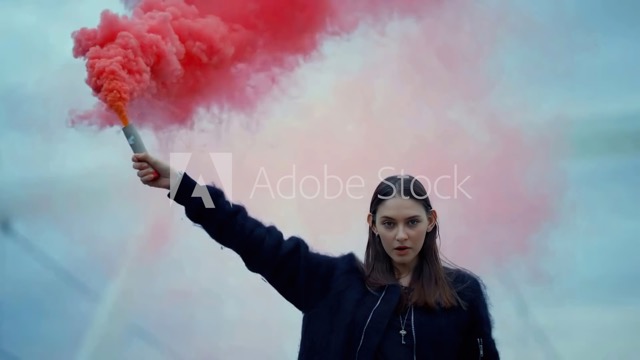
© » KADIST
Juan Obando
They/Them by Juan Obando is a video essay and deepfake that uses Adobe Stock clips, maintaining their branded watermark, but animating the scenes underneath with a narrative of self-critical awareness. It’s a meta-narrative that uses the staged scenarios (as evidence) to talk about the variable politics (and mercenary capitalism) of the stock footage industry and the misinformation dilemma we’re facing with the arrival of AI technology. In a surprising reversal, a deepfake is used to tell the truth.

© » KADIST
Fehras Publishing Practices
Borrowed Faces is a photo novel published in 2019. These framed colour photographs are selected scenes from the novel. They mimic the aesthetic of a dated comic strip but instead contain vibrantly coloured, digital photos; here the ‘live’ element of the photographic medium meets the theatrics of the graphic novel.

© » KADIST
Andrew Thomas Huang
Highly autobiographical, exquisitely made and compiling different aspects of the artist’s practice, Kiss of the Rabbit God is one of Andrew Thomas Huang’s most precise, relevant, and successful videos. This video work exemplifies a new, global wave of queering tradition, indigenous references and international pop/post-internet esthetics. In this short video, a Chinese-American restaurant worker falls in love with an 18th century Qing dynasty god of gay lovers who visits him at night and leads him on a journey of sexual awakening and self discovery.

© » KADIST
Dindga McCannon
Dindga McCannon created the radiant portrait Ima: Real Estate Mogul from the Harlem Women’s Series by first stitching material together with a sewing machine and then using more traditional painting techniques to render a portrait of Ima, a woman from Harlem who was a real estate developer from the 20th century. As with other works in the series, McCannon completes the portrait by hand beading a personal and cultural iconography of signs and symbols around the edges of the canvas. The work is spiritual in the sense that it has an energy that comes from its directness and from the human hand.

© » KADIST
Patricia Esquivias
Cardón Cardinal by Patricia Esquivias is part of a series of video works in which the artist develops a narrative in front of her computer screen. In this work, the computer sits on a covered piano keyboard, and the reflection of the artist is sometimes visible on the black surface. Cardón Cardinal is a collage of references that revolve around the removal and displacement of a 46 foot tall Pachycereus pringlei , a type of giant cactus also known as a cardón , from Baja California, Mexico to Seville, Spain.

© » KADIST
Matthew Angelo Harrison
In Hole #1 a zebra scull stands in as a representation of Africa, while the plexiglass box and the hole made through it represent the inaccessibility of that culture to African-Americans.

© » KADIST
Sandra Monterroso
Sandra Monterroso’s video performance titled Corazón del lugar del viento (Heart of the Place of the Wind) is inspired by Seis Cielo (Six Sky), the only female Mayan ruler to be represented in classical Mayan stelae (historical monuments dedicated to the record of important events). As the artist impersonates the ruler and goddess, she performs a ritual of tying stones and an offering of clothing. Seis Cielo’s ties with the lineages of the prehispanic Tikal and Dos Pilas kingdoms were essential in understanding the role of Mayan women as mothers and wives, and especially as rulers and healers.

© » KADIST
biarritzzz
biarritzzz is interested in how the development of the internet, and experimentation in the virtual world happens simultaneously with the experimentation in the material world of the human species; and how these developments reflect the precariousness of life within neoliberalism. The title of their video work Mandacura is a corruptela (a linguistic distortion on writing or pronunciation) of the Portuguese sentence Mão da Cura (Healing Hand), distorting Portuguese into what sounds as Brazilian Afro-Indigenous. Inspired by and using the music and poetry of Alberto Marques, and drawing sources from archival images, webcam videos, screenshots, gifs and memes, the video asks: What provokes our feelings toward society, history, culture, and the future?

© » KADIST
Young Min Moon
Young Min Moon’s recent paintings repetitively portray the rituals bound up in the Korean tradition of Jesa. Even amidst the disappearance of many Korean customs, Jesa, a type of Confucian ancestor veneration rites, remains a practice in South Korean society that cannot be easily discarded. Throughout the artist’s childhood, Jesa were the only moments through which he could find peace and safety in times that were rife with violence and commotion.

© » KADIST
Chto Delat
In this film is the story of two neighboring yet philosophically opposing nations: Russia and Norway. Taken through a love-story of the main character Tanja and her newfound Norwegian husband, the film challenges cultural and social norms of both places through the format of a musical. Dealing with issues of individual in society, family and moral values, Chto Delat entices the audience to consider the nuances of these two contexts.

© » KADIST
Natalia Lassalle-Morillo
La Ruta by Natalia Lassalle-Morillo follows the Panoramic Route, a now weakened infrastructure that meanders through untouched natural landscapes and off-road destinations on the island of Puerto Rico. The Panoramic Route was designed for residents and tourists to connect with the traditional center of the island, as part of a political agenda to modernize the country through infrastructure and social programs. Today, the highway is notorious for dismal road conditions, resulting in isolation between more densely populated metropolitan areas and contributing to a loss of cultural sites and practices that once took place along the Route.

© » KADIST
Gary-Ross Pastrana
Gary-Ross Pastrana’s video installation Rewilding consists of three large-scale projections placed across the exhibition space. The poetic footage filmed by the artist portrays three interconnected worlds: a colony of termites; a piano repair workshop in the outskirts of Manila; and an empty concert theatre. Their interconnectivity is shaped by the voice-over of three narrators: a musician discussing the balance between order and chaos found in classical music; a piano repairman describing termite infestations in an instrument of European origin; and a scientist describing the unique social structures of this tropical parasite.
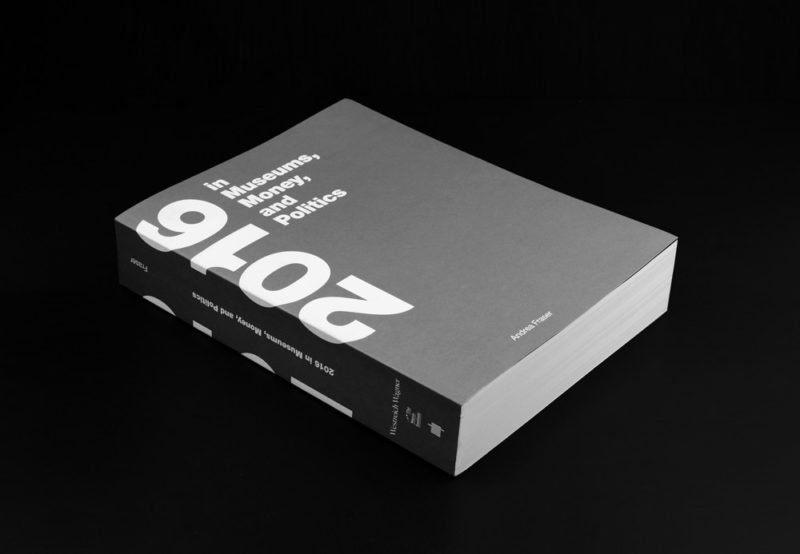
© » KADIST
Andrea Fraser
Drawing & Print (Drawing & Print)
The year 2016 is organized like a telephone book; the data corresponding to the contributions are classified in alphabetical order by the name of the donor. With this database as well as other types of information, the 900-page book presents a material representation of the scale of the cross over between cultural philanthropy and the financing of political campaigns in America. It also provides an unprecedented resource for discovering the political leaning of the museum sector.

© » KADIST
Tessa Mars
In this untitled acrylic painting, Tessa Mars explores the long-lasting effects of colonialism on the Afro-Caribbean diaspora, particularly in terms of female vulnerability and resilience. Drawing on her interest in retelling stories of her native country, and confronting the past and the present, Mars portrays her cultural essence and heritage by imagining spiritual spaces that connect people and land across time. With a pictorial practice that highlights pastel colors, the divinisation of the figures on the canvas and the spiritual elements within the composition ultimately enhance the narrative of her Caribbean ancestry while conflating the distinctions between autobiographical and historical events.

© » KADIST
Christian Nyampeta
The film Sometimes It Was Beautiful by Christian Nyampeta poetically addresses the systemic conditions leading and emerging from the 1994 Rwandan genocide, which had lasting and profound effects on Rwanda and neighbouring countries like Congo. The divergent opinions of the characters, as well as suggestive gestures, settings, and marks inscribed in the landscape highlight the different approaches in addressing the slow violence linked to the enduring impact of colonialism and imperialism, the pursuit of knowledge, and the conservation of heritage, culture, and object repatriation. Structured into six chapters, the film imagines a meeting between improbable friends and interlaces dialogues, with choreography of dancers, places and objects.

© » KADIST
Zai Kuning
Justice (2014) presents viewers with a curious assemblage: a wooden gallows with slightly curved spindles protruding from the topmost plank, which in turn is covered with rudimentary netting, the threads slackly dangling like a loose spider’s web or an rib cage that’s been cracked open. A bundle of small red rattan balls hang from the front end of the plank, precariously knotted to a single thread hanging from the gallows’ edge. A book hangs from similar red threads at the plank’s rear, its surfaced wrapped multiple times over with the thread to hold it in place, the red thread resembling blood vessels or connective tissue.

© » KADIST
Clarissa Tossin
Clarissa Tossin’s film Ch’u Mayaa responds to Frank Lloyd Wright’s Hollyhock House (constructed 1919–21) in Los Angeles, an example of Mayan Revival architecture. By re-appropriating the structure as a temple and imbuing it with a dance performance based on movements and postures found in ancient pottery and murals, the choreography takes its influence from the house’s design and the body positions on ancient Maya ceramics and buildings. A pulse, breathing, and a pre-Columbian clay flute are among the sounds on the soundtrack.

© » KADIST
Lynn Hershman Leeson
Using the seminal 1958 film Vertigo as a launchpad, Lynn Hershman Leeson explores the blurred lines between fact and fantasy in VertiGhost , a film commissioned by the Fine Arts Museums in San Francisco. VertiGhost features the re-creation of select scenes from Vertigo (which takes place in San Francisco), documentation of the life of a painting by Amedeo Modigliani in the Legion of Honor’s collection that was enshrouded by questions of authenticity, as well as interviews—including with the original film’s star Kim Novak— about the construction of realities in life and art. By thoughtfully overlaying these conversations and events, Hershman Leeson distills complex conversations around identity and authenticity into concise insights in just over 12 minutes.

© » KADIST
Enrique Ramirez
In Un Hombre que Camina (A Man Walking) (2011-2014), the sense of rhythm and timing is overpowered by the colossal sense of timelessness of this peculiar place. Shot in Uyuni, Bolivia, the film depcits world’s largest salt flat, a site that sits in a mountainous region at over twelve thousand feet above sea level. Ramirez’s work is deeply invested in the loss of regional identity, and the anachronistic dress of his “modern-day shaman” in the film is meant to reconcile the historical and cultural gaps between tribal traditions of a specific time and place and the all-too-prevalent homogeneity brought on by advanced capitalism.
Gregory Halpern
Gregory Halpern is an acclaimed American photographer whose practice is predicated on wandering...
Arseny Zhilyaev
Arseny Zhilyaev is arguably one of the most influential contemporary Russian artists of his generation...
Zai Kuning
- year born: 1964
- gender: male
- nationality: Singaporean
- home town: Singapore
Nazgol Ansarinia
- location: Tehran, Îran
- year born: 1979
- gender: female
- nationality: Iranian
Matthew Angelo Harrison
Detroit’s Matthew Angelo Harrison works at the intersection of sculpture and technology, building his own 3D printers (which rise to the status of sculpture), and using these creations to formulate others...
Sheroanawe Hakihiiwe
Sheroanawe Hakihiiwe is a Yanomami artist who lives and works in Upper Orinoco, at the Venezuelan side of the Amazon rainforest...
Claudia Joskowicz
Claudia Joskowicz is a video and installation artist working at the intersection of landscape, history, and memory...
Kota Ezawa
- location: San Francisco, California
- year born: 1969
- gender: male
- nationality: German
- home town: Cologne, Germany
Brian Tripp
Brian D...
Young Min Moon
Young Min Moon is a Korean American artist, curator, critic, and art historian, who migrated to the United States from South Korea as a teenager...
Pierre Gonnord
Pierre Gonnord is known for his large scale photographic portraits of people who inhabit the fringes of society...
Lynn Hershman Leeson
- location: San Francisco, California
- year born: 1941
- gender: female
- nationality: American
- home town: Cleveland, Ohio
Yan Xing
- location: Beijing, China
- year born: 1986
- gender: male
- nationality: Chinese
- home town: Chongqing, China
Farah Al Qasimi
Working primarily with photography, video and performance, Farah Al Qasimi examines postcolonial structures of power, gender, and taste in the Gulf Arab states...
Samson Young
Samson Young is a Hong Kong-based artist whose practice interlays multiple narratives and references with sound and cultural politics at its heart...
Sandra Monterroso
Sandra Monterroso is a Guatemalan artist of Maya Q’eqchi’ decent...
Ahmad Fuad Osman
Ahmad Fuad Osman is of a generation that came of age in a Malay world whose artists were eager to speak about socio-political issues on terms that broadened questions of nationhood, ethnicity, faith, and historical fact, doubtful of the grand narrative that had been propounded since the race riots of the late 1960s...
Pu Yingwei
Working as an artist, writer and curator, Pu Yingwei’s practice addresses key issues of our contemporary world linked to collective memory, personal history, utopia, identity, and geopolitics...
Martin Kippenberger
- location: Vienna, Austria
- year born: 1953
- gender: male
- nationality: German
- home town: Dortmund, Germany
Dale Harding
A descendant of the Bidjara, Ghungalu, and Garingbal peoples, Dale Harding’s work references and expands upon the philosophical and spiritual touchstones of his cultural inheritance...
Haegue Yang
- location: Berlin, Germany & Seoul, South Korea
- year born: 1971
- gender: female
- nationality: Korean
- home town: Seoul, South Korea
Clarissa Tossin
- location: Los Angeles, California
- year born: 1973
- gender: female
- nationality: Brazilian
- home town: Porto Alegre, Brazil
Gary-Ross Pastrana
Gary-Ross Pastrana is an artist interested in the philosophies of art and the epistemologies of the art object...
Bili Bidjocka
A visual artist and curator, Bili Bidjocka’s practice confronts market laws, history, and his own Cameroonian identity...
Yuri Ancarani
Yuri Ancarani’s films are quasi-hypnotic devices; following highly unique bodily and site-specific choreographies, drawing sensitive portraits of human relations...
Bani Abidi
Bani Abidi’s practice deals heavily with political and cultural relations between India and Pakistan; she has a personal interest in this, as she lives and works in both New Delhi and Karachi...
Chto Delat
Chto Delat was founded in 2003 and consists of a group of artists, critics, philosophers, and writers from Petersburg, Moscow, and Nizhny Novgorod...
Andrew Thomas Huang
Andrew Thomas Huang is one of the most original upcoming film makers working at the intersection of tradition, spirituality, non-Western imaginary, queerness, and digital fantasies and technical possibilities...
Park Chan-Kyong
Artist and filmmaker Park Chan-kyong was born in Seoul under the reign of Park Chung-hee, whose authoritarian rule transformed South Korea from an impoverished, war-torn country into what the artist describes as a ‘militaristic, repressive, modern state.’ The shadows of Japanese occupation and the Korean War loomed large over the period, driving the call for nationalism and productivity...
-
1970-1979
Aubrey Williams
1972Carib Carnival illustrates Aubrey Willams’s unique artistic language, combining Pre-Columbian iconography with abstraction...
Malick Sidibé
1976Au bord du Fleuve Niger (1976) offers a unique insight into the lives of the 1970s in Bamako...
Julius Koller
1978This work is one of Koller’s many variations which he began to use from 1970 to describe the ‘cultural situations’ he created...
-
1980-1989
Jean-Marie Straub and Danièle Huillet
1982En rachâchant is based on the short story Ah! Ernesto! (1971) by Marguerite Duras in which the child Ernesto does not want to go to school anymore as all that he is taught are things he does not know...
Martin Kippenberger
Drawing & Print
1989(Drawing & Print) 7″ Single ‘Pop In’ by Martin Kippenbergher consisting of a vinyl record and a unique artwork drawn by the artist on the record’s sleeve...
-
1990-1999
Frédéric Nauczyciel
1999This early photographic work by Fre?de?ric Nauczyciel, titled Untitled (Boîte à prière, Istanbul, Novembre 2005) , features a young man in religious attire reading a religious text from inside a glass prayer box...
-
2000-2009
William E. Jones
2000His series, The Golden State, harkens back to his early career and his photographic training...
Pierre Gonnord
2002Nakayama is part of a larger body of work by Pierre Gonnord focusing on the analysis and description of the lifestyles of urban youth in large Western cities...
Kota Ezawa
2002The Simpson Verdict is a three-minute animation by Kota Ezawa that portrays the reading of the verdict during the OJ Simpson trial, known as the “most publicized” criminal trial in history...
Mario Garcia Torres
2005Mario Garcia Torres films a game of Charades among professional actors guessing the former North Korean dictator’s favorite Hollywood films...
Carla Zaccagnini
2005This series of photographs, Sobre la igualdad y las diferencias: casas gemelas (On Equality and Differences: Twin Houses) , taken in Havana in 2005, belongs to a wider group of works that the artist has been developing over many years, generally titled Bifurcaciones y encrucijadas (Forking Paths and Crossroads) ...
Lynn Hershman Leeson
2007Lynn Hershman Leeson’s genre-bending documentary Strange Culture tells the story of how one man’s personal tragedy turns into persecution by a paranoid, conservative, and overzealous government...
Ahmad Fuad Osman
2007Recollections of Long Lost Memories by Ahmad Fuad Osman is a series of 71 black and white sepia-toned archival photographs that chart, with nostalgia, the social encounters between hierarchies of life in the Malay world...
Goddy Leye
2008Strongly influenced by history and memory, Goddy Leye’s paintings are based primarily on stories and mythologies...
Bili Bidjocka
2009The short two-channel video Pause/Tanmpo takes its cue from a coincidental encounter artist Bili Bidjocka had in Dakar...
Claudia Joskowicz
2009The primary interest in the trilogy is Joskowicz’s use of cinematic space, with long tracking shots that portray resistance to habitual viewing experiences of film and television...
-
2010-2019
Takeshi Murata
2010If one had been guessing at Takeshi Murata’s criticism of American consumerist culture up until watching Infinite Doors , it would be solidified after hearing the announcer from The Price is Right squawk prizes one after the next...
Brian Tripp
2010For many years Tripp has been involved in reviving Karuk ceremonies that had been discontinued for decades, he developed his signature abstract style, based in Karuk design, ceremonial regalia forms, and related cultural and political iconography...
Brian Tripp
2010For many years Tripp has been involved in reviving Karuk ceremonies that had been discontinued for decades, he developed his signature abstract style, based in Karuk design, ceremonial regalia forms, and related cultural and political iconography...
Wimo Ambala Bayang
2011Composed of four images, the series Sleeping Elephant in the Axis of Yogyakarta (2011) explores the artist’s observation of how Javanese mythology and cosmology have marked the geography of Yogyakarta, the cultural centre of Indonesia...
Johanna Calle
Drawing & Print
2011(Drawing & Print) Johanna Calle’s Abece “K” (2011) is part of a series of drawings (compiled into an artist book called Abece ) based on the alphabet...
Katia Kameli
2012Katia Kameli’s film The Storyteller explores the cultural role of deep-rooted artistic tradition in Morocco...
Santiago Borja
2012Cosmic Tautology I and II are two textile pieces representative of Santiago Borja’s practice and long-standing interest in disrupting universalist assumptions of minimalism by connecting them with other, non-Western or esoteric references...
Maria Taniguchi
2012Untitled (Celestial Motors) is a visual meditation on an icon of modern urban Philippine life—the jeepney...
Ana Roldán
2012Ana Roldán’s Primeval forms series looks up close at the fecund shapes of plants often found in the artist’s native Mexico...
Bani Abidi
2012The perceived effortlessness of power, projecting above experiences of labored subordination is examined in Death at a 30 Degree Angle by Bani Abidi, which funnels this projection of image through the studio of Ram Sutar, renowned in India for his monumental statues of political figures, generally from the post-independence generation...
Ryan Gander
2012Epiphany…learnt through hardship is composed of a bronze sculpture depicting the model of the little dancer of Degas, in the pose of a female nude photographed by Edward Weston (Nude, 1936) accompanied by a blue cube...
Elena Damiani
2012Intersticio (Interstice) by Elena Damiani traces the topography of a non-specific site, an in-between zone...
Haris Epaminonda
2012Haris Epaminonda’s work questions the manipulation and the flow of images as well as their power of fascination...
Angelica Mesiti
2013Angelica Mesiti’s piece, The Calling (2013-14) is a poignant exploration of ancient human traditions evolving and adapting to the modern world...
Rometti Costales
2013This anarchist flag is made from Huayruro seeds, a native plant of South and Central American tropical areas...
Sharif Waked
2013Tughra is a protocol by Sharif Waked that reproduces the sixteenth century calligraphic monogram for tughra ; also known as the signature of Suleiman the Magnificent...
Maya Watanabe
2013Three men with their backs to each other, dressed similarly in dark colors, stare straight at the camera...
Nazgol Ansarinia
2013In the early 2000s, as urban redevelopment accelerated and intense construction significantly diminished public space in Tehran, state-funded murals began to represent imaginary landscapes on building facades...
Yao Jui-Chung
2013Long Long Live (2013) takes the viewer to the setting of the Oasis Villa on Green Island, once a reform and re-education prison to house political prisoners during Taiwan’s martial law period...
Zai Kuning
2014Justice (2014) presents viewers with a curious assemblage: a wooden gallows with slightly curved spindles protruding from the topmost plank, which in turn is covered with rudimentary netting, the threads slackly dangling like a loose spider’s web or an rib cage that’s been cracked open...
Sara Eliassen
2014Sara Eliassen’s video work A Blank Slate (2014) employs cinematic effect to investigate the relationships between subjectivity, gaze, and memory...
Mungo Thomson
2014Starting with Bruce Nauman’s iconic artwork, The True Artist Helps the World by Revealing Mystic Truths (Window or Wall Sign) , Mungo Thomson’s neon sign is one of a series that replaces Nauman’s quixotic mini-manifesto with aphorisms from ‘recovery’ culture, especially those made popular by alcoholics anonymous...
Zai Kuning
Drawing & Print
2014(Drawing & Print) Converting is a piece about the Orang Laut, often called Sea Nomads, that inhabited the Riau archipelago...
Samson Young
2014In Muted Situations #2: Muted Lion Dance by Samson Young, Chinese lion dancers perform the auspicious procession traditionally presented at special occasions such as weddings or during the Lunar New Year...
Shimon Minamikawa
2014In Play , the image comes from a fashion magazine from the 1950’s (USA) whose theme is costume sportswear from the 19th century...
Zai Kuning
Drawing & Print
2014(Drawing & Print) Concerned with the early history of Singapore, Zai Kuning spent many years living with and researching the history of the Riau peoples who were the first inhabitants of Singapore...
Matthew Angelo Harrison
2015In Hole #1 a zebra scull stands in as a representation of Africa, while the plexiglass box and the hole made through it represent the inaccessibility of that culture to African-Americans....
biarritzzz
2015biarritzzz is interested in how the development of the internet, and experimentation in the virtual world happens simultaneously with the experimentation in the material world of the human species; and how these developments reflect the precariousness of life within neoliberalism...
Taloi Havini
2015Following her family’s political exile to Australia in 1990, Havini began to document her journey’s home to the north of Buka Island, in the Autonomous Region of Bougainville...
Beatriz Santiago Muñoz
2015Marché Salomon by Beatriz Santiago Muñoz depicts two meat vendors, a young man and woman, chatting in Marché Salomon, a busy Port-au-Prince market...
Claudia Joskowicz
2015Some Dead Don’t Make a Sound (Hay muertos que no hacen ruido) is a single-channel video by Claudia Joskowicz that features the Mexican legend of the Weeping Woman (La Llorona) as its main protagonist...
Gregory Halpern
2016Gregory Halpern spent five years shooting ZZYZX , and another year editing the results, from an estimated thousand rolls of film, about half of which were shot in the final year after his Guggenheim Fellowship enabled him to live in California...
Gregory Halpern
2016Gregory Halpern spent five years shooting ZZYZX , and another year editing the results, from an estimated thousand rolls of film, about half of which were shot in the final year after his Guggenheim Fellowship enabled him to live in California...
Gregory Halpern
2016Gregory Halpern spent five years shooting ZZYZX , and another year editing the results, from an estimated thousand rolls of film, about half of which were shot in the final year after his Guggenheim Fellowship enabled him to live in California...
Matthew Angelo Harrison
2016In Bodily Study of Unthinking Groups, Harrison combines two disparate materials into one stratified stack: automotive clay (used in detailing cars) forms the earthy base, while fragments of zebra skull become imbedded in this falsified soil...
Wade Guyton
Drawing & Print
2016(Drawing & Print) This untitled print by Wade Guyton depicts an iteration of elements that are characteristic of the artist’s work...
Gregory Halpern
2016Gregory Halpern spent five years shooting ZZYZX , and another year editing the results, from an estimated thousand rolls of film, about half of which were shot in the final year after his Guggenheim Fellowship enabled him to live in California...
Gregory Halpern
2016Gregory Halpern spent five years shooting ZZYZX , and another year editing the results, from an estimated thousand rolls of film, about half of which were shot in the final year after his Guggenheim Fellowship enabled him to live in California...
Gregory Halpern
2016Gregory Halpern spent five years shooting ZZYZX , and another year editing the results, from an estimated thousand rolls of film, about half of which were shot in the final year after his Guggenheim Fellowship enabled him to live in California...
Martine Syms
2016Her 2016 video installation quotes the sitcom-as-form and also draws from a 1907 comedic short, Laughing Gas...
Gregory Halpern
2016Gregory Halpern spent five years shooting ZZYZX , and another year editing the results, from an estimated thousand rolls of film, about half of which were shot in the final year after his Guggenheim Fellowship enabled him to live in California...
Gregory Halpern
2016Gregory Halpern spent five years shooting ZZYZX , and another year editing the results, from an estimated thousand rolls of film, about half of which were shot in the final year after his Guggenheim Fellowship enabled him to live in California...
Gregory Halpern
2016Gregory Halpern spent five years shooting ZZYZX , and another year editing the results, from an estimated thousand rolls of film, about half of which were shot in the final year after his Guggenheim Fellowship enabled him to live in California...
Haegue Yang
2016A steel clothing rack adorned with turbine vents, Moroccan vintage jewelry, pinecones and knitting yarn, these heterogeneous elements are used here to create an exotic yet undefined identity within the work...
Gregory Halpern
2016Gregory Halpern spent five years shooting ZZYZX , and another year editing the results, from an estimated thousand rolls of film, about half of which were shot in the final year after his Guggenheim Fellowship enabled him to live in California...
Gyempo Wangchuk
2016The various distinct but connected lineages of Himalayan painting remain thriving languages employed by artists from across the region to express their unique perspective in our shared contemporary world...
Yuri Ancarani
2016The Wedding is a silent film, a probing observation of marriage rituals in Qatar in which we soon notice that there is not a single woman visible...
Tatsuki Masaru
2016For the works KAKERA, Bullet Train and KAKERA, Loving God Tatsuki Masaru traveled throughout Japan to visit museums holding kakera (which translates to “fragments”) of Jomon Period potteries –Japan’s pre-history 2,300-15,000 years ago...
Jorge González
2017Easy to fold and carry, Jorge González’s Banquetas Chéveres (Chéveres Stools) embody the nomadic and flexible nature of the Escuela de Oficios...
Lynn Hershman Leeson
2017Using the seminal 1958 film Vertigo as a launchpad, Lynn Hershman Leeson explores the blurred lines between fact and fantasy in VertiGhost , a film commissioned by the Fine Arts Museums in San Francisco...
Clarissa Tossin
2017Clarissa Tossin’s film Ch’u Mayaa responds to Frank Lloyd Wright’s Hollyhock House (constructed 1919–21) in Los Angeles, an example of Mayan Revival architecture...
Lungiswa Gqunta
2017Feet Under Fire by Lungiswa Gqunta depicts the artist’s lower legs swinging in and out of frame, above a bed of charcoal...
Colectivo Los Ingrávidos
2017The word Coyolxauhqui refers to femicide or the killing of women in rural Mexico on the basis of gender...
Sinzo Aanza
2017Projet d’attentat contre l’image? (Acte 3) by Sinzo Aanza brings together literature and objects in their varied forms...
Kota Ezawa
2017The Crime of Art is an animation by Kota Ezawa that appropriates scenes from various popular Hollywood films featuring the theft of artworks: a Monet painting in The Thomas Crown Affair (1999), a Rembrandt in Entrapment (1999), a Cellini in How to Steal a Million (1966), and an emerald encrusted dagger in Topkapi (1964)...
Farah Al Qasimi
2017Farah Al Qasimi’s approach to photography deviates from the norms and conventions of traditional figurative and portrait photography...
Chloé Quenum
2017The stained glass windows of Chloé Quenum’s Les Allégories evoke the sacred and describe the movement of a rooster in the form of patterns extracted from a wax fabric found in Benin...
Christian Nyampeta
2018The film Sometimes It Was Beautiful by Christian Nyampeta poetically addresses the systemic conditions leading and emerging from the 1994 Rwandan genocide, which had lasting and profound effects on Rwanda and neighbouring countries like Congo...
Natalia Lassalle-Morillo
2018La Ruta by Natalia Lassalle-Morillo follows the Panoramic Route, a now weakened infrastructure that meanders through untouched natural landscapes and off-road destinations on the island of Puerto Rico...
Gary-Ross Pastrana
2018Gary-Ross Pastrana’s video installation Rewilding consists of three large-scale projections placed across the exhibition space...
Lala Rašcic
2018In Greek mythology, Arachne was a talented mortal weaver who challenged Athena, goddess of wisdom and crafts, to a weaving contest; this hubris resulted in her being transformed into a spider...
Che Onejoon
2018Che Onejoon’s unsettling video My Utopia opens with a round table of women asking and answering the questions “Who am I? Where did I come from? Where should I go?” One of the women featured is Monique Macías, the daughter of Francisco Macías Nguema, the first Prime Minister of Equatorial Guinea...
Juan Brenner
2018The photographic series Tonatiuh (The Son of the Sun) by Juan Brenner is an in-depth visual study of current Guatemalan society from the perspective of miscegenation and the incalculable consequences of the Spanish conquest...
Native Art Department International
2018The neon sign Walk the Walk (Sam Durant) overlays a Walk/Don’t Walk Sign crosswalk sign onto the text “You Are On Indian Land Show Some Respect.” The sign asks viewers to not walk on Indigenous lands without respecting it, and, switching between a walking person icon in white and a raised hand icon in red, redirects their actions...
Pooja Gurung and Bibhusan Basnet
2018DADYAA: The Woodpeckers of Rotha by Pooja Gurung and Bibhusan Basnet illuminates a unique and seldom seen international perspective on indigenous cultures and contemporary social issues in the Nepali context...
Calderón & Piñeros (La Decanatura)
2018Calderón & Piñeros (La Decanatura) refer to Sólheimasandur as a work that tackles the issue of “the ruin as a tourist destination.” As they say, “at the end, tourists become an essential part of this unusual, beautiful, and—at the same time—banal landscape.” The video features a plane wreck on Sólheimasandur beach in Iceland, where a navy plane belonging to the United States Army crashed in 1973 due to fuel exhaustion...
Dale Harding
2018Dale Harding’s installation Body of Objects consists of eleven sculptural works that the artist based on imagery found at sandstone sites across Carnarvon Gorge in Central Queensland...
Marguerite Humeau
2018This work forms part of a project that draws upon research into the use of psychoactive substances present in animal brains during the Paleolithic period...
Tarik Kiswanson
2018In late 2017, Kiswanson stared working with Vadim, an eleven-year-old Romanian-French boy who he met during castings for a performance...
Andrés Pereira Paz
2018Juan III (Pescadores En Una Isla) is a series of embroideries made with fake pre-Columbian fabrics produced by the Gonzales family, a three-generation family of pre-Columbian textile “forgers” based in Lima, Peru...
siren eun young jung
2018Taking the same name as their most recent solo show at the Kunstverein für die Rheinlande und Westfalen in Düsseldorf, siren eun young jung’s video work Deferral Theatre intertwines various threads from the last decade of the artist’s research into the Yeoseong Gukgeuk theatrical form, in which all of the roles are played by women, as well as performance-based modes of queer resistance in South Korea...
Cecilia Bengolea
2018Lightning Dance by Cecilia Bengolea is a black and white video that considers the relationship between extreme weather and the body...
Ana María Millán
2019Interested in role-play and videogames, Ana María Millán developed workshops with different communities in order to create characters and scenarios for her animations, often in collaboration with a choreographer...
Andrew Thomas Huang
2019Highly autobiographical, exquisitely made and compiling different aspects of the artist’s practice, Kiss of the Rabbit God is one of Andrew Thomas Huang’s most precise, relevant, and successful videos...
Ayoung Kim
2019In 2019, Ayoung Kim traveled to Mongolia to research its widespread animistic belief system towards land, mother rock, stones, and sacred caves that purify human guilt...
Karla Dickens
2019Karla Dickens’s collage Beneath the skim board addresses issues of discrimination and racism towards Indigenous communities in Australia through a constellation of historical and current events...
He Xiangyu
2019He Xiangyu’s Terminal 3 presents excerpts from the lives of young African acrobats attending the Hebei Wuqiao Acrobatic Arts School in China...
Park Chan-Kyong
2019Park Chan-Kyong’s otherworldly film Belated Bosal primarily follows two women as they navigate their way up a spectral mountain and through what appears to be a history museum or nuclear disaster bunker...
Kameelah Janan Rasheed
2019Calvin Warren calls it an ‘ontological equation’/or methods of estimating the odds to rise in the coming centuries by Kameelah Janan Rasheed is part of A Casual Mathematics , a series of interpretive art diagrams, which revisit W...
Iván Argote
2019Iván Argote’s As Far As We Could Get comprises a series of video chapters made in the municipality of Palembang, Indonesia and the small town of Neiva, Colombia...
Matt Kane
Advanced Technology
2019(Advanced Technology) Matt Kane initiated the project Right Place & Right Time – Bitcoin Volatility Art in 2019...
Sheroanawe Hakihiiwe
2019Wateoma husipe / Larvas de oruga / Caterpillar larvae by Sheroanawe Hakihiiwe exemplify his most abstract work, where he choses particular elements of a living organism to create his renditions...
Sheroanawe Hakihiiwe
2019Perawesi / Estómago de animal / Stomach of animal by Sheroanawe Hakihiiwe exemplify his most abstract work, where he choses particular elements of a living organism to create his renditions...
-
2020-2029
Andrea Fraser
Drawing & Print
2020(Drawing & Print) The year 2016 is organized like a telephone book; the data corresponding to the contributions are classified in alphabetical order by the name of the donor...
Patricia Esquivias
2020Cardón Cardinal by Patricia Esquivias is part of a series of video works in which the artist develops a narrative in front of her computer screen...
Ashmina Ranjit
2020While most of Ashmina Ranjit’s work has been large-scale installations, often immersive and site-specific, the series Hair Warp – Travel Through Strand of Universe is a brilliant concentration of both her beliefs and aesthetic...
Paloma Contreras Lomas
Drawing & Print
2020(Drawing & Print) Paloma Contreras Lomas sometimes incorporates large scale drawing into her practice...
Pu Yingwei
2020ChinaCapital: Dream, Hot Land, Interstellar Colonization by Pu Yingwei addresses a complicated phenomena of intertwined influences from different political powers, capital forces, and ideologies in the reality of China...
rafa esparza
2020thanks for staying alive Fern.1994 by rafa esparza is from a body of work that pays homage to youth culture in the 90s...
Dindga McCannon
2021Dindga McCannon created the radiant portrait Ima: Real Estate Mogul from the Harlem Women’s Series by first stitching material together with a sewing machine and then using more traditional painting techniques to render a portrait of Ima, a woman from Harlem who was a real estate developer from the 20th century...
Ishola Akpo
2021Noticing the lack of archives on the queens of various African kingdoms, artist Ishola Akpo created several series of work that retrace their history...
Sofía Córdova
2021Set some time in the future, Sofía Córdova’s multi-channel film installation GUILLOTINÆ Wanna Cry, Act Yellow: Break Room imagines a public that worships pop stars and revolutionary leaders equally...
Nathan Lewis
Drawing & Print
2021(Drawing & Print) Nathan Lewis has always made figurative and abstract drawings, which are related to anatomical textures and patterns he encountered when working as an ICU nurse...
Sandra Monterroso
2022Sandra Monterroso’s video performance titled Corazón del lugar del viento (Heart of the Place of the Wind) is inspired by Seis Cielo (Six Sky), the only female Mayan ruler to be represented in classical Mayan stelae (historical monuments dedicated to the record of important events)...
Young Min Moon
2022Young Min Moon’s recent paintings repetitively portray the rituals bound up in the Korean tradition of Jesa...
Tessa Mars
2022In this untitled acrylic painting, Tessa Mars explores the long-lasting effects of colonialism on the Afro-Caribbean diaspora, particularly in terms of female vulnerability and resilience...
Hoda Afshar
2022In the islands of the Strait of Hormuz off the southern coast of Iran, a distinctive local culture has emerged as the result of many centuries of cultural and economic exchange, the traces of which are seen not only in the material culture of these islands but also in the customs and beliefs of their inhabitants...
Farah Al Qasimi
2022Um Al Dhabaab (Mother of Fog) by Farah Al Qasimi addresses the myth of Al Qasimi tribe-instigated piracy in the Gulf, perpetuated by the British Empire and upheld by contemporary western academia...
Lotus Laurie Kang
2022Scaffold by Lotus Laurie Kang features a seemingly disjointed amalgamation of materials between flat fabrics and lumps of aluminum...
Young Min Moon
2022Young Min Moon’s recent paintings repetitively portray the rituals bound up in the Korean tradition of Jesa ...
Yuyan Wang
2022One Thousand and One Attempts to Be an Ocean by Yuyan Wang reflects on the experience of not being able to see the world with depth perception...
Walid Raad
2022For his first NFT release artist Walid Raad made a series of animated birthday cakes, titled Festival of Gratitude , for some of the world’s most toxic and larger-than-life leaders...
Risham Syed
2022Risham Syed discovered a box of woven Chinese silk panels that was her mother’s most prized possession...
Juan Obando
2023They/Them by Juan Obando is a video essay and deepfake that uses Adobe Stock clips, maintaining their branded watermark, but animating the scenes underneath with a narrative of self-critical awareness...


